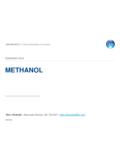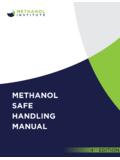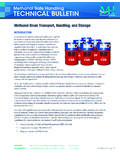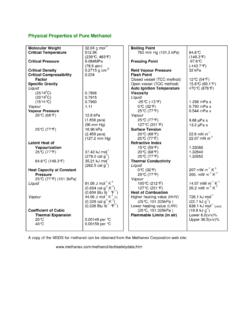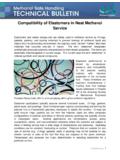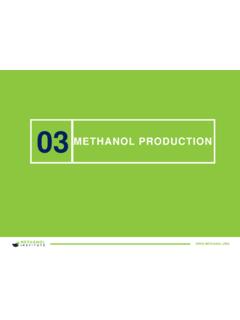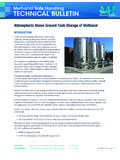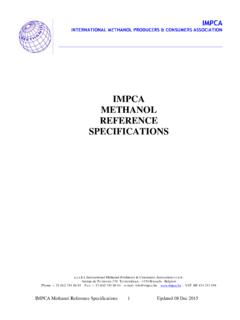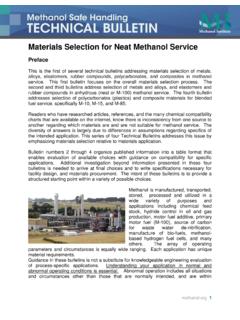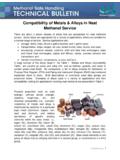Transcription of Methanol Gasoline Blends
1 Blends Alternative Fuel For Today sAutomobiles and Cleaner BurningOctane For Today s Oil RefineryMethanol blending Technical Product Suntec Tower Three 8 Temasek Blvd Singapore 038988 + DC 4100 North Fairfax Drive, Suite 740, Arlington, VA 22203 BlendingTechnical Product BulletinTABLE OF CONTENTSSECTIONS:I. IntroductionII. Physical PropertiesIII. Octane ImprovementIV. blending Vapour PressureV. Distillation PropertiesVI. Vehicle Emission ImprovementsVII. Material Compatibility Methanol Methanol - Gasoline BlendsVIII.
2 Water SolubilityIX. Storage and Handling RequirementsX. Global Methanol Fuel blending RegulationsXI. Environmental and Health EffectsXII. ReferencesDisclaimer of LiabilityAs the conditions or methods of use of Methanol and other alcohols by you and third parties are beyond our control, we do not assume responsibility and expressly disclaim any liability for any use of Methanol blending . Information contained herein is believed to be true and accurate but all statements or suggestions are made without warranty, express or implied, regarding accuracy of the information, the hazard connected with the use of Methanol , or the results to be obtained from the use thereof, nor should freedom from any patent owned by others be inferred.
3 No conclusion may be drawn from the tests with materials specified in this bulletin with respect to any components or material included in the list of tested Suntec Tower Three 8 Temasek Blvd Singapore 038988 + DC 4100 North Fairfax Drive, Suite 740, Arlington, VA 22203 INTRODUCTIONM ethanol is a clean burning, high octane blending component made from alternative non-petroleum energy sources such as natural gas, coal and biomass. It has been commercially blended into Gasoline at various times and locations since 1980.
4 Although Methanol has been widely manufactured for use in chemical production, Methanol has also been successfully used for extending Gasoline supplies in many Gasoline markets around the world. Unlike some other alcohols, Methanol blending in Gasoline has been economical without government subsidies or fuel blending providing non-petroleum alternative energy into Gasoline supplies, blending Methanol also delivers a clean burning high octane to the oil refiner s Gasoline supplies that can be used reduce the refiner s energy consumption as well as improve Gasoline yields from the crude oil.
5 Methanol s high octane and oxygen content produce a cleaner burning Gasoline which significantly lowers vehicle exhaust emissions. When produced from natural gas or biomass, Methanol fuel has a lower carbon intensity (or carbon footprint) than Gasoline produced from the crude oil price shocks of the 1970 s, Methanol blending in Gasoline was first introduced commercially in the early1980 s. Because carburetted fuel systems were most prevalent in the vehicle fleets on the road at that time, and because those vehicles had limited ability to handle high oxygen levels in the fuel, Methanol Blends were generally limited to 3 to 5 volume percent of the Gasoline blend .
6 However, with today s modern pressurised fuel injector systems with computerised feedback control loops, current experience shows that Methanol Blends as high as 15 volume percent (M15) of the Gasoline can now be successfully used in the more modern vehicles that are on the road has many fuel properties that make it cleaner burning in Gasoline engines. Besides containing oxygen for improved fuel combustion, Methanol also has a high blending octane value for smoother burning, a lower boiling temperature for better fuel vapourisation in cold engines, the highest hydrogen-to-carbon ratio for a lower carbon intensity fuel, and no sulphur contamination which poisons catalytic converter operation.
7 These unique blending properties allow oil refiners to produce cleaner burning Gasoline that reduces vehicle emissions, which are precursors to ozone and particulate matter (PM) in the atmosphere. blending high octane Methanol also replaces aromatic compounds normally used for adding octane in Gasoline , but which also contribute to toxic emissions from vehicles. In addition, blending Methanol also allows oil refiners to expand Gasoline production, upgrade regular Gasoline production to higher premium grade Gasoline , and meet new environmental specifications as well as minimise refinery capital investments to achieve these the oil refinery, using Methanol Blends is one of the lowest cost means to expand Gasoline supplies to meet the growing Gasoline demand and new environmental regulations, and thereby delay capital investment in refinery processing capacity.
8 For developing economies around the globe, the blending of Methanol in Gasoline is one of the quickest and lowest cost means for both displacing high cost petroleum energy consumed in the existing vehicle fleet, and also for reducing vehicle emissions that lead to air pollution such as ozone, carbon monoxide (CO), PM and air BlendingTechnical Product Suntec Tower Three 8 Temasek Blvd Singapore 038988 + DC 4100 North Fairfax Drive, Suite 740, Arlington, VA 22203 blending Technical Product BulletinII.
9 PHYSICAL PROPERTIESM ethanol is a clear, low viscosity liquid with a faintly sweet alcohol odour at low concentrations in air. Chemically, Methanol is an aliphatic alcohol containing about 50 wt% oxygen with physical properties consistent with other alcohols used as Gasoline blending components (see Table 1).As is common for most alcohols blended in Gasoline , Methanol is fully soluble in water and also miscible with Gasoline -type hydrocarbons (HC). The addition of some cosolvent alcohols (ethanol, propanols, or butanols) are generally required in methanolgasoline Blends to provide adequate water tolerance (solubility) or phase stability under colder temperature conditions.
10 As with most gasolines and alcohol fuel Blends , inhibitors or additives are generally recommended with Methanol Blends to provide added protection against metal corrosion. Properly blended Gasoline with Methanol is typically compatible with materials commonly used in Gasoline distribution systems as well as vehicle fuel systems. Neat fuel Methanol (premixed with co-solvents and corrosion inhibitors) is handled in a similar manner as Gasoline or other Gasoline blending components with the exception of certain materials of construction and added precaution to keep the fuel Methanol dry.
